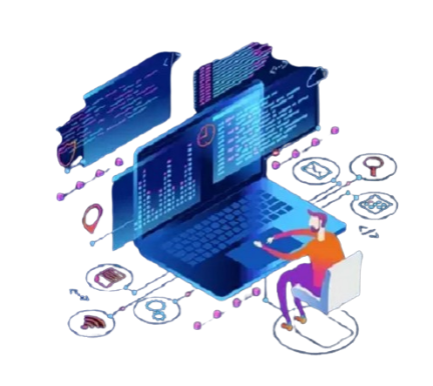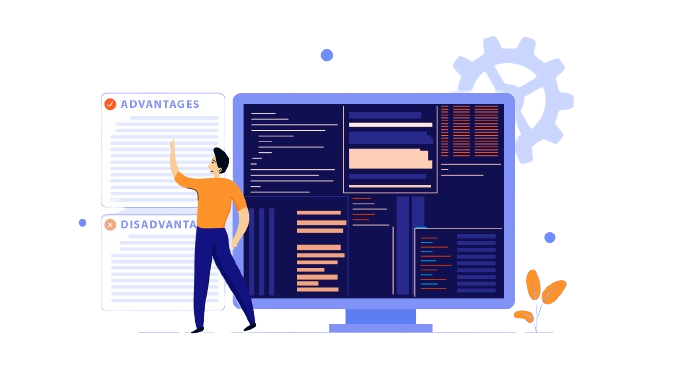RESOURCE CENTRE
FOR SOFTWARE DEVELOPMENT
FOR SOFTWARE DEVELOPMENT
RELEVANT TECHNOLOGIES
Technology involves the utilisation of scientific knowledge, tools, methodologies, and frameworks to devise solutions, commodities, and services aimed at meeting human requisites, resolving challenges, or enhancing prevailing methodologies. Encompassing a broad spectrum of advancements, it extends from rudimentary implements and machinery to intricate frameworks integrating sophisticated machinery, software, and digital interfaces. Its essence lies in harnessing knowledge to forge implements that streamline tasks, rendering them more facile, efficient, and sometimes even viable initially.
Programming languages are often referred to as technology because they are fundamental tools used to create, implement, and operate technological solutions. These languages provide the means to communicate instructions to computers, enabling developers to design software, build hardware systems, and develop various technological innovations.

Programming languages serve as the fundamental building blocks in the creation of software, hardware, and technological solutions that significantly impact human life. Their relevance is profound and pivotal in the realm of technology, offering a bridge between human intent and the functionalities of machines. Understanding the significance, advantages, and disadvantages of programming languages in technological development provides insights into their integral role in shaping our digital world.
Relevance and Significance:
Programming languages serve as the means of communication between human programmers and computers. They enable developers to instruct machines on how to perform specific tasks, whether it's designing software applications, developing hardware components, or creating solutions that cater to human needs. Their relevance lies in their ability to translate human-readable code into machine-readable instructions, thereby driving innovation and progress in various domains.
Programming languages serve as the means of communication between human programmers and computers. They enable developers to instruct machines on how to perform specific tasks, whether it's designing software applications, developing hardware components, or creating solutions that cater to human needs. Their relevance lies in their ability to translate human-readable code into machine-readable instructions, thereby driving innovation and progress in various domains.
Advantages:
- Versatility: Programming languages come in diverse forms, each designed to serve specific purposes. High-level languages like Python, Java, and JavaScript offer simplicity and readability, making them accessible for beginners and adaptable for various applications. Low-level languages like C and Assembly provide precise control over hardware but require a deeper understanding of computer architecture.
- Efficiency: Well-designed programming languages contribute to the efficiency of software and hardware development. They enable developers to write concise, optimized code that executes tasks more rapidly and effectively. This efficiency is critical in delivering solutions that meet user requirements while optimizing resources.
- Innovation and Adaptability: The evolution of programming languages drives innovation. New languages often emerge with enhanced features, better performance, or specific focuses, fostering creativity and adaptability in solving complex problems. The ability to adapt to changing technological landscapes ensures continued relevance and advancement.
- Community and Support: Popular programming languages often have extensive communities of developers, offering support, libraries, and resources. This ecosystem fosters collaboration, knowledge-sharing, and the development of robust solutions through collective expertise.

Disadvantages:
- Learning Curve: Some programming languages, especially those with complex syntax or low-level languages, can pose a steep learning curve for beginners. Mastering these languages may require significant time and effort.
- Compatibility and Portability: Compatibility issues arise when different programming languages or platforms are used within the same project. Ensuring compatibility across systems and platforms might pose challenges, impacting the scalability and portability of solutions.
- Security Concerns: Certain programming languages might be more prone to security vulnerabilities if not used correctly. Improper coding practices or language-specific weaknesses can result in security breaches and threats to data integrity.
- Performance Trade-offs: Depending on the language used, there can be performance trade-offs. High-level languages might sacrifice some performance for ease of use, while low-level languages might offer more control but at the expense of development speed.
Programming languages are integral to technological development, shaping the software, hardware, and solutions that enhance human experiences. Their significance lies in enabling communication between humans and machines, fostering innovation, efficiency, and adaptability. While they offer numerous advantages in driving progress, they also pose challenges related to complexity, compatibility, security, and performance. Understanding these facets helps navigate the vast landscape of programming languages, empowering developers to harness their capabilities effectively for the betterment of society.
Germane Techs